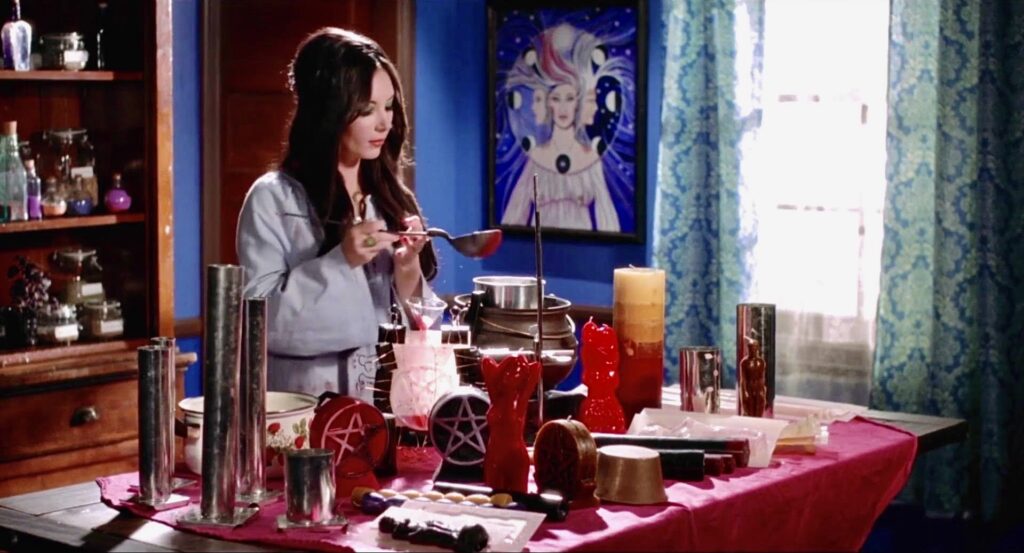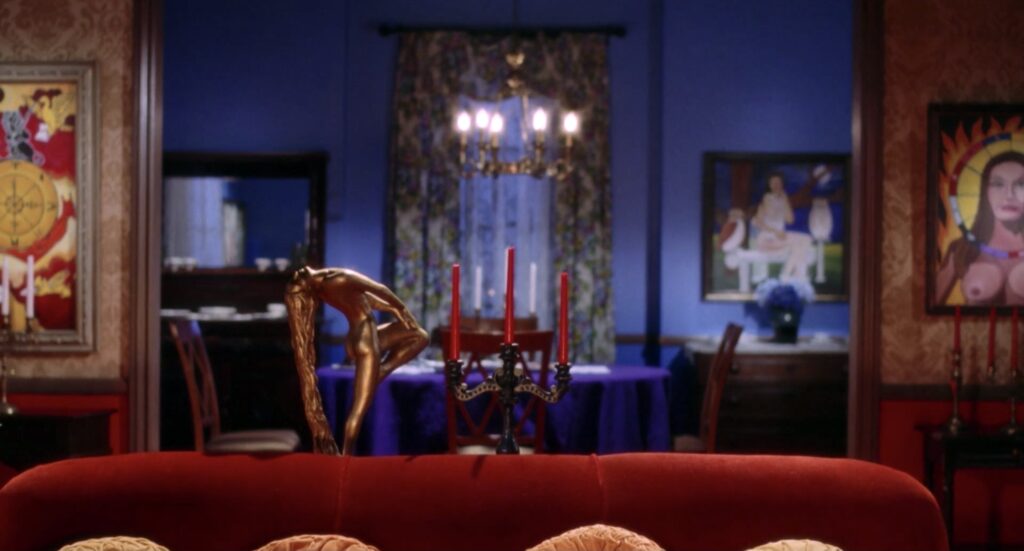Anna Biller’s 2016 film The Love Witch transcends time. In a technicolor gaze of vibrant blue eyeshadow, a pink tea room, a crimson suitcase, and a purple Victorian mansion, the film is as vintage as it is modern. Set in an ambiguous time period, the only allusion of it not taking place in the 1960s is the odd cellphone, the modern cars parked along the street, and the rare contemporary building among the historic structures of a quaint California coastal town.
Among the pastel pinks and blues of the town looms the mesmerizing purple mansion. It stands out as a gothic beauty distinct from the rest of the neighborhood. The house is adorned with gold trimmings, a pointed turret (appropriately called a “witch’s hat turret”), and an embellished round entrance. Elaine (Samantha Robinson), a glamorous young witch with a penchant for love potions and murder, swoops into town and moves into an apartment within the ornate Queen Anne mansion. Elaine’s apartment is garishly decorated with occult paraphernalia and psychedelic wallpaper. The house is a witchy haven for Elaine where she can brew potions and spells, which she hopes will fulfil her obsessive desire for love.

Although The Love Witch was filmed in Northern California (the Victorian mansion is a real-life 1888 historic landmark called the Bair-Stokes house in Arcata, California), the film exists in its own dreamscape of a world. Biller truly made the film her own; she was the director, writer, producer, editor, composer, costume designer, and production designer. She meticulously crafted this world of Elaine’s, taking seven and a half years to complete her film. Every detail of the production and costume design was created in the vision of Elaine’s inner state, her aesthetic fantasy of glamour and power. Biller explained, “I like to make films with a kind of dream logic. My films are a mix of reality and fantasy, or a mix of what is happening and what people wish was happening, or what they fear will happen. So, for instance, Elaine’s house is a fantasy witch house, because that’s the house she dreams of.”

I like to make films with a kind of dream logic. My films are a mix of reality and fantasy, or a mix of what is happening and what people wish was happening, or what they fear will happen.
Director Anna Biller
In order to ensure that her vision was realized, Biller either handpicked the vintage and custom-made set pieces or made them herself. She spent six months making a pentagram rug by hand and painted much of the kitschy artwork that appears in Elaine’s apartment. The precision to detail and elaborate mix of Victorian and 60s gothic designs in the apartment gives the feeling of stepping into a nebulous time period of Elaine’s creation. The few pieces of the modern world that exist in the town do not make their way into the house, creating the sense that both the house and Elaine’s apartment are as timeless as the film itself.


Biller colour-schemed the apartment based on a fabled tarot deck, the Thoth Tarot. The film set is a kaleidoscopic vision of blues, purples, and reds. When explaining the chosen look, Biller said, “A lot of choices were made symbolically or to reinforce character and theme. The décor was the same—it came from Tarot cards and from the desire to combine Victorian and hippie elements together, to go with [Elaine’s] personality.”
The apartment is decorated with stain-glass lampshades, floral curtains, figurines, voodoo dolls, and candelabras with everlasting flames. The rooms are split into sun imagery with warm colors, and moon imagery with cool colors, inspired by the Tarot cards. The symbolism is a visual representation of the discordance between Elaine’s desire for love and her need for absolute power. Yet, in her space, these two parts of herself can coexist peacefully while the outside world questions these opposing desires.
Elaine’s home is a timeless sanctuary of feminine power where her candy-colored world is untouched by reality, giving her the ideal place to fulfil her fantasy as the love witch.
